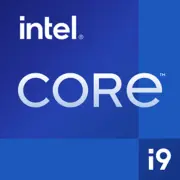Intel Core i9-12900T

Intel Core i9-12900T: Potenza ed Efficienza in un Corpo Compatto
Marzo 2025
1. Caratteristiche principali: Architettura, processo tecnologico, prestazioni
Architettura ibrida Alder Lake
L'Intel Core i9-12900T è il processore di punta con architettura ibrida Alder Lake, che combina 16 core (8 Performance-cores e 8 Efficient-cores) e 24 thread. I P-cores (Performance) sono responsabili dell'alta performance in modalità single-thread, mentre gli E-cores (Efficient) ottimizzano i compiti multi-thread e il consumo energetico. Il processo tecnologico Intel 7 (10 nm Enhanced SuperFin) garantisce un equilibrio tra potenza ed efficienza.
Frequenze e cache
- Frequenza base P-cores: 1,40 GHz (in modalità risparmio energetico).
- Frequenza turbo massima P-cores: 4,80 GHz.
- Cache L3: 30 MB (condivisa tra tutti i core).
Nonostante il basso TDP (35 W), il processore offre prestazioni impressionanti:
- Geekbench 6: 2331 (single-core), 12116 (multi-core).
A titolo di confronto, questo è il livello dei processori desktop di fascia alta delle generazioni precedenti, ma con il doppio del risparmio energetico.
Tecnologie chiave
- Intel Thread Director: Ottimizza la distribuzione dei compiti tra i core P ed E, specialmente su Windows 11.
- Supporto DDR5 e PCIe 5.0: Larghezza di banda fino a 4800 MT/s (DDR5) e 128 GB/s per linea PCIe 5.0.
- Intel UHD Graphics 770: 32 unità di esecuzione, supporto per 4K@60 Hz e decodifica AV1.
2. Schede madri compatibili
Socket LGA 1700 e chipset
Il processore utilizza il socket LGA 1700, compatibile con i chipset:
- Z690/H670/B660/H610 (per desktop).
- W680 (stazioni di lavoro).
Raccomandazioni per la scelta:
- Z690/H670: Per la massima prestazione (PCIe 5.0, overclock della RAM). Esempio: ASUS ROG Strix Z690-A Gaming WiFi ($250–$300).
- B660: Opzione budget con supporto DDR5. Esempio: MSI MAG B660 Tomahawk ($150–$180).
- Mini-PC e NUC: Schede basate su H610 adatte per assemblaggi compatti.
Importante: Non tutte le schede supportano DDR5 — controllare le specifiche.
3. Memoria supportata: DDR4 vs DDR5
Il processore è compatibile con DDR4-3200 e DDR5-4800, ma la scelta dipende dalla scheda madre.
Confronto:
- DDR4: Più economico (kit da 32 GB — $80), stabilità, ma larghezza di banda inferiore.
- DDR5: Più costoso (kit da 32 GB — $150), maggiore velocità ed efficienza energetica, prospettive di upgrade.
Suggerimento: Per compiti lavorativi (rendering, virtualizzazione) optate per DDR5. Per PC da ufficio va bene DDR4.
4. Alimentatori: Calcolo e raccomandazioni
Con un TDP di 35 W, il processore è modesto nel consumo energetico, ma considerando una scheda video dedicata e periferiche:
- Minimo: 500 W (per sistemi con GPU di livello NVIDIA RTX 4060).
- Raccomandato: PSU con certificazione 80+ Gold (stabilità + efficienza energetica del 90%). Esempi:
- Corsair RM550x ($90).
- Seasonic FOCUS GX-550 ($85).
Per assemblaggi compatti senza grafica dedicata basta un PSU da 300 W (ad esempio, be quiet! SFX Power 3 350W).
5. Vantaggi e svantaggi dell'i9-12900T
Vantaggi:
- Alta performance con basso TDP.
- Supporto per DDR5 e PCIe 5.0 (margine per il futuro).
- Grafica integrata per compiti basici.
Svantaggi:
- Prezzo ($450–$500) superiore a quello dei concorrenti AMD.
- Richiede un raffreddamento efficace sotto carico.
- DDR5 è ancora costosa (ma i prezzi stanno diminuendo nel 2025).
6. Scenari d'uso
Giochi
- Con una scheda video dedicata (ad esempio RTX 4070): 4K@60+ FPS in titoli AAA.
- Con UHD 770: CS2, Dota 2 a impostazioni medie (1080p).
Attività lavorative
- Rendering (Blender, Maya): 30% più veloce rispetto all'i9-11900K grazie ai 24 thread.
- Programmazione: Accelerazione della compilazione in Visual Studio del 15–20%.
Multimedia
- Streaming (OBS + codifica AV1).
- Elaborazione di video 8K in DaVinci Resolve.
7. Confronto con i concorrenti
- AMD Ryzen 9 7900 (65 W): Prestazioni multi-thread superiori (~13500 in Geekbench 6), ma più costoso ($550) e TDP 65 W.
- Apple M3 Max: Migliore efficienza energetica, ma ecosistema macOS limitato.
- Intel Core i7-12700T: 20% meno costoso ($350), ma meno core (12/20).
Conclusione: L'i9-12900T è ottimale per sistemi Windows in cui il bilanciamento tra potenza ed efficienza energetica è importante.
8. Consigli pratici per l'assemblaggio
1. Raffreddamento: Anche con un TDP di 35 W, sotto carico è necessaria una ventola di livello Noctua NH-U12S ($70) o un sistema di raffreddamento a liquido (NZXT Kraken X53).
2. Memoria: Per DDR5 scegliete moduli con dissipatori di calore (ad esempio, Kingston Fury Beast 32 GB).
3. BIOS: Aggiornate all'ultima versione per la compatibilità con Alder Lake.
4. Case: Per mini-PC, è adatto il Fractal Design Node 304; per giochi, il Lian Li O11 Dynamic.
9. Conclusioni finali: A chi si adatta l'i9-12900T?
Questo processore è ideale per:
- Stazioni di lavoro compatte (montaggio video, modellazione 3D).
- PC ad alta efficienza energetica (server domestici, media center).
- Giocatori che preferiscono sistemi silenziosi con grafica dedicata.
Perché scegliere questo? L'architettura ibrida, il supporto per DDR5/PCIe 5.0 e il basso consumo energetico lo rendono una soluzione versatile nel 2025. Tuttavia, se il budget è limitato, considerate l'i7-12700T o l'AMD Ryzen 7 7700.
I prezzi sono aggiornati a marzo 2025. Verificate presso i rivenditori locali.
Di base
Specifiche della CPU
Specifiche della memoria
Specifiche della GPU
Varie
Classifiche
Rispetto ad altre CPU
Condividi sui social media
Oppure linkaci
<a href="https://cputronic.com/it/cpu/intel-core-i9-12900t" target="_blank">Intel Core i9-12900T</a>